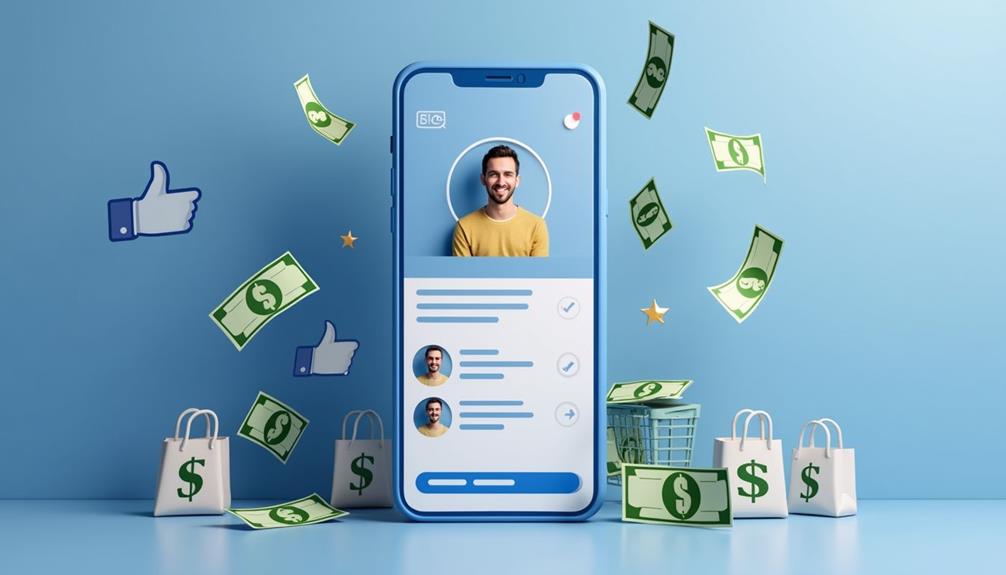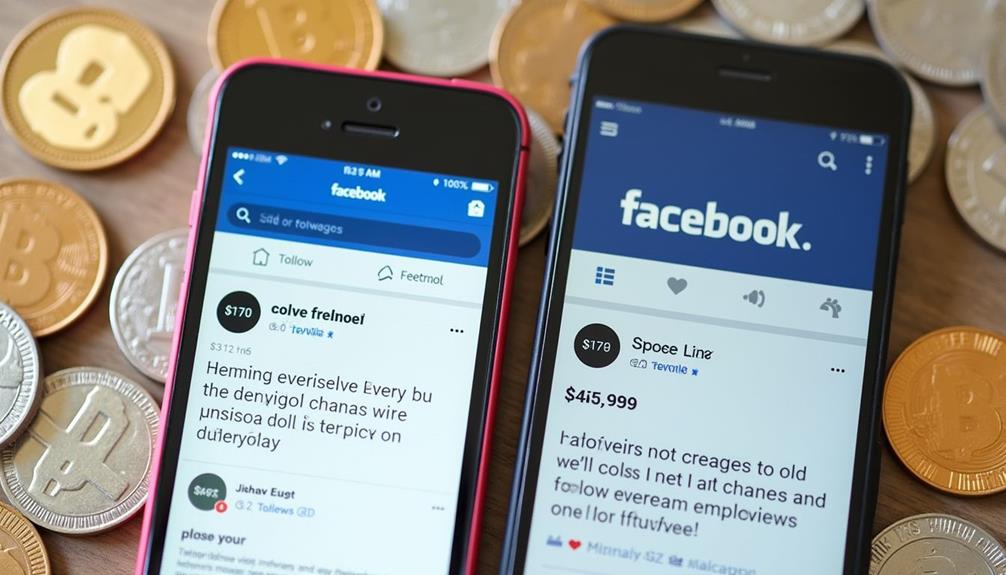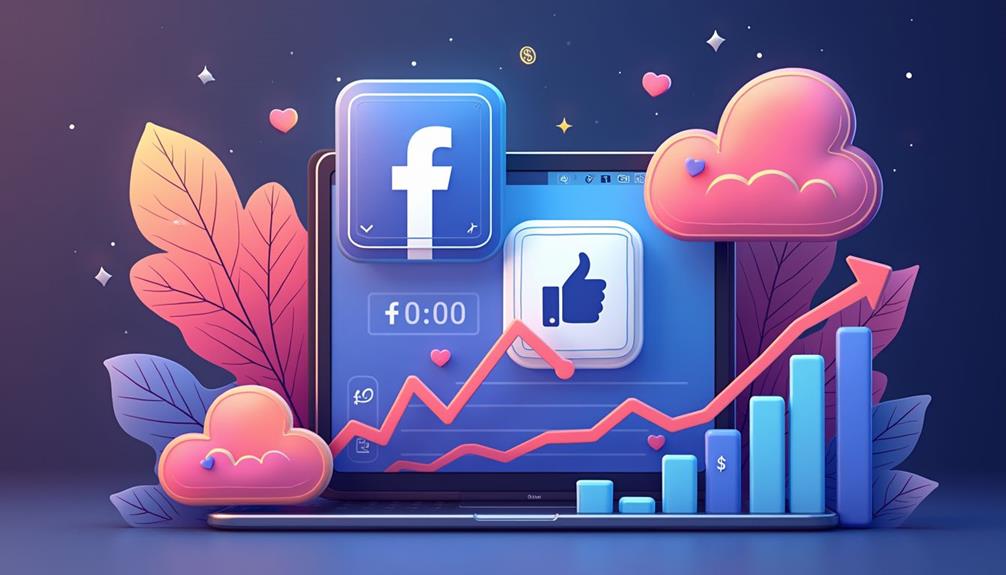
Does Facebook pay for 100 followers?
Imagine chasing a mirage, thinking Facebook will compensate you for a mere 100 followers. You might have heard tales that it’s enough to start earning, but the reality is far from that. Facebook’s monetization policies focus more on engagement and substantial follower counts. To access revenue streams like ad breaks, you need at least 10,000 followers and specific engagement metrics. So, why is there a myth around 100 followers, and what should you be doing instead to monetize your content effectively?
Key Takeaways
- Facebook does not pay users based solely on having 100 followers.
- Monetization requires meeting specific eligibility criteria, including follower count and engagement levels.
- Authentic engagement and high-quality content are prioritized over follower numbers for revenue generation.
- Ad breaks require at least 10,000 followers and 30,000 one-minute views on videos longer than three minutes.
- Meaningful interactions and consistent engagement are crucial for earning potential on Facebook.
Facebook’s Monetization Policies

Facebook’s monetization policies, which are both thorough and evolving, play an indispensable role in how content creators and businesses generate revenue on the platform. To maximize your earnings, understanding these policies is vital.
Facebook offers various monetization strategies, including ad breaks, fan subscriptions, branded content, and in-stream ads. Each strategy has specific eligibility requirements, such as minimum follower counts and engagement metrics.
In particular, the importance of followers can’t be overstated. A substantial and engaged follower base greatly impacts your ability to monetize content effectively. For instance, ad breaks require at least 10,000 followers and 30,000 one-minute views on videos longer than three minutes in the last 60 days. This policy underscores how follower importance directly ties to revenue potential.
Data-driven insights reveal that creators with higher follower counts often see increased ad revenue and fan support. However, it’s not just about quantity; follower engagement quality highly affects income.
Innovative content that drives interaction can help you meet and exceed Facebook’s monetization thresholds. By focusing on building a loyal, active audience, you enhance your potential to leverage Facebook’s monetization strategies, turning your content into a consistent revenue stream.
Understanding Follower Metrics
Grasping the intricacies of Facebook’s monetization policies requires a deep understanding of follower metrics. Knowing how followers affect your reach and engagement is essential. Follower significance is not just about numbers; it’s about how actively your audience interacts with your content. High engagement rates can amplify your visibility on the platform, making your profile more attractive to advertisers.
To help you understand the key metrics, here’s a breakdown:
| Metric | Description |
|---|---|
| Follower Count | Total number of people following your page. |
| Engagement Rate | Ratio of interactions (likes, comments, shares) to total followers. |
| Reach | Number of unique users who see your content. |
| Click-Through Rate (CTR) | Percentage of followers who click on your links. |
Analyzing these metrics allows you to refine your engagement strategies. For instance, if your engagement rate is low, you might need to post more interactive content like polls or live videos. Understanding follower significance helps you target your efforts more effectively, leading to better monetization results.
The Myth of 100 Followers

You might think that having 100 followers will automatically boost your visibility on Facebook, but that’s a common misconception.
Social media algorithms prioritize authentic engagement over follower count, meaning real interactions matter more.
Data shows that meaningful engagement can greatly impact your reach and influence more than simply amassing followers.
Common Misconceptions Explained
One prevalent misconception about Facebook is the belief that accumulating 100 followers will access financial rewards or special privileges from the platform. This notion isn’t supported by evidence. Facebook’s monetization strategies don’t hinge on follower count alone but rather on engagement metrics and content quality.
Understanding follower psychology is essential. People follow profiles that offer value—whether through entertainment, information, or community. Simply amassing followers without a robust content strategy won’t yield significant engagement or financial benefits. High-quality content that resonates with your audience is key to driving interactions, which Facebook values more than mere follower numbers.
Data shows that profiles with strategic content plans see higher engagement rates, which is more likely to attract monetization opportunities. For instance, businesses and influencers who focus on diversified content—videos, live streams, and interactive posts—tend to perform better. This approach aligns with Facebook’s algorithm favoring engaging, shareable content.
Social Media Algorithms
Understanding the mechanics of social media algorithms is crucial for anyone looking to debunk the myth that having 100 followers on Facebook translates to financial gain.
Facebook’s algorithm updates prioritize content relevance and user interaction over sheer follower count. Engagement strategies are essential; without high interaction rates, your posts won’t achieve ideal content visibility.
Algorithm transparency remains limited, but it’s understood that ranking factors include reactions, comments, and shares. Audience targeting further complicates things, as the platform uses data to deliver content to users most likely to engage.
Content visibility isn’t guaranteed simply by having followers; it requires strategic reach enhancement.
Platform changes can also affect how content is distributed. For example, updates may prioritize content from friends and family over brand pages, impacting your reach. As a result, relying solely on follower count without adapting to these changes is futile.
To navigate these complexities, focus on producing relevant, engaging content. This guarantees your posts align with the algorithm’s goals, maximizing your audience’s interaction.
To summarize, algorithm dynamics debunk the 100-follower myth, highlighting the crucial role of engagement and relevance in content distribution.
Authentic Engagement Matters
While social media algorithms prioritize interaction over follower count, genuine engagement emerges as the cornerstone of effective content distribution on Facebook. You might think having 100 followers is a breakthrough, but without authentic interactions, those numbers mean little.
Data indicates that posts with higher engagement rates—likes, comments, shares—are more likely to be featured prominently in users’ newsfeeds.
Consider this: Facebook’s algorithm favors content that sparks meaningful conversations. If your 100 followers are inactive or disengaged, your reach and impact will be minimal.
Authentic engagement drives organic growth, resulting in a more substantial and dedicated audience over time. Metrics show that posts with genuine comments and interactions can boost visibility by up to 50%.
Invest in creating content that resonates with your audience and encourages participation. Authentic interactions not only improve your content’s reach but also build a loyal community.
Instead of focusing on follower count, prioritize quality engagement. In the long run, a smaller but more engaged audience will outperform a large, inactive follower base.
Ultimately, organic growth stems from real, meaningful connections, not just numbers.
Eligibility for Earnings
To start earning through Facebook, creators must meet specific eligibility criteria designed to guarantee quality and engagement. First and foremost, you need to hit the earnings threshold set by Facebook. This threshold varies depending on the type of monetization tool you’re using, but typically, it’s a combination of follower count, engagement metrics, and content consistency.
For instance, Facebook’s in-stream ads program requires a minimum of 10,000 followers and 30,000 one-minute views on videos that are at least three minutes long within the last 60 days. These criteria guarantee that only creators who consistently produce engaging content can monetize effectively. By setting these standards, Facebook aims to incentivize quality over quantity, promoting meaningful interactions rather than superficial follower counts.
Additionally, follower incentives play an important role in meeting these eligibility requirements. Facebook’s algorithms favor content that drives user interaction, so you’re encouraged to create posts that spark comments, shares, and likes. High engagement not only helps you meet the earnings threshold but also amplifies your reach, making it easier to grow your follower base organically.
Meeting these eligibility criteria can be challenging, but they’re vital for ensuring that the platform remains a space for innovative and high-quality content.
Revenue Streams on Facebook

Exploring the various revenue streams on Facebook, you’ll find that the platform offers multiple avenues for monetization, each tailored to different types of content and audience engagement.
Analyzing these opportunities can help you determine the most effective strategies for maximizing your earnings.
1. Advertising Revenue: Through Facebook’s Ad Breaks program, you can integrate short ads into your videos.
This method requires meeting certain eligibility criteria, such as having 10,000 followers and 30,000 one-minute views on videos longer than three minutes. Ad revenue is calculated based on the number of views and engagement rates.
2. Brand Partnerships: Collaborating with brands allows you to create sponsored content.
Facebook’s Brand Collabs Manager connects you with potential partners who align with your niche. Successful partnerships depend on the alignment of your audience demographics with the brand’s target market, ensuring mutual benefits.
3. Fan Subscriptions: This feature enables your followers to subscribe to exclusive content for a monthly fee.
It’s particularly beneficial for creators with loyal fanbases who seek premium access. Facebook takes a percentage of the subscription fee, making it essential to provide value that justifies the cost.
Role of Engagement
Engagement plays a pivotal role in determining your success on Facebook. Your ability to foster meaningful audience interaction directly impacts your reach and influence. Studies show that posts with high engagement rates—likes, comments, shares—are prioritized by Facebook’s algorithm, amplifying your content’s visibility. This isn’t just about numbers; it’s a signal to the platform that your content resonates with users.
To boost engagement, employ data-driven engagement strategies. Analyze your audience’s behavior to identify peak interaction times and tailor your content accordingly. Interactive content, such as polls and live videos, often garners higher engagement rates. A Facebook study revealed that live videos generate six times more interactions than regular videos, underscoring the power of real-time engagement.
Don’t underestimate the importance of consistency. Regular posting schedules maintain audience interest and foster habitual interaction. Furthermore, prompt responses to comments and messages enhance audience loyalty, making followers feel valued. According to Sprout Social, brands that reply to audience interactions see a 48% increase in customer loyalty.
Ultimately, strategic engagement is key to accessing Facebook’s full potential. By prioritizing authentic audience interaction and leveraging data, you can greatly elevate your platform presence and drive success.
Comparing to Other Platforms

When you compare Facebook to other platforms like Instagram and YouTube, you’ll notice significant differences in payment criteria and engagement value metrics.
Instagram emphasizes visual content and influencer partnerships, while YouTube focuses on ad revenue and watch time.
Understanding these distinctions helps you evaluate which platform aligns best with your monetization goals.
Payment Criteria Differences
Facebook’s monetization strategies for followers differ greatly from other social media platforms, each with its unique set of criteria. Unlike Facebook, platforms like YouTube and Instagram offer more direct revenue streams tied to follower counts and engagement. However, Facebook emphasizes payment methods that are influenced heavily by follower quality rather than sheer numbers.
When you’re comparing Facebook to other platforms, consider these key differences:
- Payment Methods: Facebook primarily uses ad revenue and partnerships for monetization, while YouTube offers direct ad revenue, membership fees, and Super Chats. Instagram leans on sponsored posts and IGTV ads.
- Follower Quality: Facebook’s algorithms prioritize the quality of interactions. They assess engagement levels, such as comments and shares, to determine monetization eligibility, unlike platforms that might simply count followers.
- Content Requirements: Facebook demands a diverse content portfolio, including video, live streams, and articles, to maximize revenue potential. In contrast, YouTube focuses primarily on video content, and Instagram centers around visual posts and stories.
Engagement Value Metrics
Quantifying the value of user engagement reveals stark contrasts between Facebook and other social media platforms like YouTube and Instagram. On Facebook, engagement strategies often center around likes, comments, and shares. However, the value assigned to these interactions can be less impactful compared to YouTube’s video views or Instagram’s photo likes and comments.
On YouTube, follower interaction is heavily monetized through AdSense, where creators earn revenue based on ad views and engagement rates. High engagement metrics such as watch time and comments can greatly boost a channel’s earnings.
Instagram, on the other hand, leverages its visually driven platform to maximize brand collaborations and sponsored posts. Here, engagement strategies revolve around aesthetic appeal and authenticity, driving higher interaction rates that can translate into lucrative partnerships.
When comparing these platforms, Facebook’s engagement value metrics might seem less financially rewarding. However, Facebook’s diverse content types and extensive user base offer unique opportunities for long-term engagement and community building.
Understanding these differences allows you to tailor your approach, maximizing the effectiveness of your engagement strategies across platforms. In principle, while Facebook may not directly pay for followers, optimizing follower interaction on this platform can still yield considerable benefits.
Case Studies and Examples
Examining case studies and examples sheds light on whether Facebook financially incentivizes users to gain followers. In one case, a viral content creator with a diverse follower demographic reported no direct payment from Facebook for reaching 100 followers. Instead, revenue generation came from ad placements and sponsored posts. This indicates that Facebook’s financial incentives are tied to content monetization rather than follower count.
Consider the following case studies:
- Tech Influencer: A tech blogger with 50,000 followers didn’t receive payments from Facebook for follower milestones. Instead, they earned income through ad revenue and product endorsements driven by high engagement rates.
- Lifestyle Vlogger: This vlogger saw massive growth due to viral content but noted that their monetization stemmed from brand partnerships, not the follower count itself. Their follower demographics were essential for attracting brands targeting specific audiences.
- Small Business Owner: A small business with 1,000 followers reported no financial compensation from Facebook for follower gains. Their revenue came through increased sales driven by engaging posts and targeted ads.
These examples demonstrate that while having a substantial follower base is beneficial, Facebook’s monetary rewards are linked to content engagement and external partnerships, not merely follower acquisition.
Growing Your Follower Count

Understanding that financial rewards on Facebook are tied more to content engagement and partnerships rather than follower count, it’s still important to grow your follower base effectively. To achieve this, leveraging various follower strategies is key. Focus on organic growth through content quality and niche targeting. High-quality content tailored to a specific audience can greatly boost audience engagement.
| Strategy | Description |
|---|---|
| Content Quality | Consistently post high-quality, valuable content |
| Niche Targeting | Focus on a specific, well-defined audience |
| Community Building | Engage with your audience and foster discussion |
| Influencer Collaboration | Partner with influencers to reach a wider audience |
| Visual Storytelling | Use visuals to tell compelling stories |
Community building is essential. Engage with your followers through comments and messages to create a loyal community. Influencer collaboration can also amplify your reach. Partnering with influencers allows you to tap into their established follower bases.
Brand consistency guarantees your content is recognizable and trustworthy. Visual storytelling, using images and videos, can make your posts more engaging. Finally, social proof, such as testimonials and user-generated content, can validate your page’s value, attracting more followers.
Realistic Expectations
When setting goals for your Facebook growth, it’s important to have realistic expectations about the outcomes. Achieving a high follower count can be enticing, but the quality of followers often outweighs the quantity.
Here are three critical points to take into account when planning your strategy:
- Engagement Rates: High follower numbers don’t guarantee interaction. Focus on follower quality by targeting users genuinely interested in your content. This leads to higher engagement rates, which Facebook algorithms favor.
- Conversion Potential: Realistic goals should include metrics beyond just follower count. Evaluate how many of these followers convert into customers or active community members. Data shows that targeted and engaged followers are more likely to take desired actions.
- Sustainable Growth: Rapid growth can sometimes lead to a diluted follower base. Implementing strategies that aim for steady, organic growth makes sure that your audience remains relevant and engaged over time.
This long-term approach is more sustainable and beneficial for your brand.

